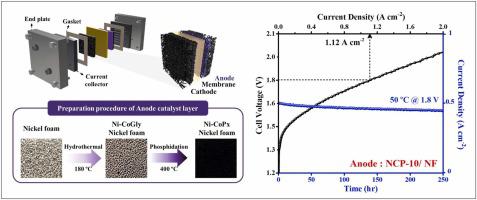Applied Catalysis B: Environment and Energy ( IF 20.2 ) Pub Date : 2023-02-10 , DOI: 10.1016/j.apcatb.2023.122444 Deok-Hye Park , Min-Ha Kim , Myungjae Kim , Jeong-Hyeon Byeon , Jae-Sung Jang , Ji-Hwan Kim , Da-Mi Lim , Seon-Ha Park , Yun-Hui Gu , Jiwoong Kim , Kyung-Won Park

|
Anion exchange membrane water electrolysis (AEMWE) uses a zero-gap membrane-electrode-assembly (MEA) consisting of a polymer electrolyte membrane and non-precious metal-based catalysts. However, anode catalysts for the oxygen evolution reaction (OER), which is the rate-determining-step in WE, need to be intensively developed to achieve superior electrocatalytic activity and stability. Herein, we report the synthesis and characterization (experimental and simulation) of spherical Ni-doped (5–15 at%) cobalt phosphide (Ni-CoP) as the anode catalyst for the OER. Specifically, the DFT calculation exhibited that the addition of Ni in CoP might increase the energy density in the Fermi level of pristine CoP, enhance the charge transfer rate during the OER, and reduce the energy barrier for the formation of OOH* , thereby boosting the OER activity. The prepared Ni-doped CoP catalyst was directly loaded onto a foam-type Ni-based gas diffusion layer for effective application in AEMWE. It was found that the electrocatalytic activity of the AEMWE depends on the porosity of the NFs as catalyst substrates. The unit cell containing the membrane-electrode-assembly fabricated with NCP-10 delivered a high current density of 1.12 A cm−2 at 1.8 V and a low reduction rate of 0.64 mA cm−2 h−1 for 250 h.
中文翻译:

球形镍掺杂磷化钴作为碱性介质中析氧反应的阳极催化剂:从催化到系统
阴离子交换膜水电解 (AEMWE) 使用由聚合物电解质膜和非贵金属基催化剂组成的零间隙膜电极组件 (MEA)。然而,需要集中开发用于析氧反应 (OER) 的阳极催化剂,这是 WE 中的决速步骤,以实现优异的电催化活性和稳定性。在此,我们报告了球形掺镍(5-15 at%)磷化钴(Ni-CoP)作为 OER 阳极催化剂的合成和表征(实验和模拟)。具体而言,DFT 计算表明,在 CoP 中添加 Ni 可能会增加原始 CoP 费米能级的能量密度,提高 OER 过程中的电荷转移速率,并降低 OOH* 形成的能垒,从而提高开放教育资源活动。将制备的掺杂 Ni 的 CoP 催化剂直接负载到泡沫型 Ni 基气体扩散层上,以有效应用于 AEMWE。发现 AEMWE 的电催化活性取决于作为催化剂底物的 NFs 的孔隙率。包含用 NCP-10 制造的膜电极组件的单元电池可提供 1.12 A cm 的高电流密度-2在 1.8 V 和 0.64 mA cm -2 h -1的低还原率下持续 250 小时。


















































 京公网安备 11010802027423号
京公网安备 11010802027423号